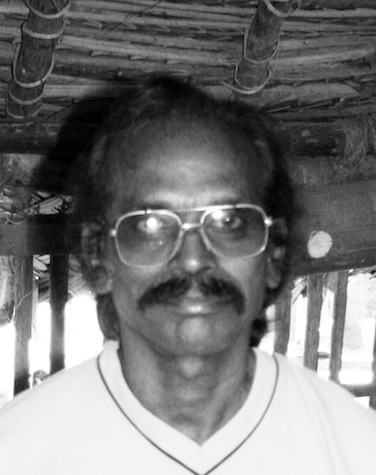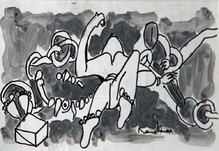
P.S. Nandhan
Chennai, India Born 1940
-
From 14 Apr-2006 To 10 May-2006
-
From 01 Dec-2015 To 14 Jan-2016
Attained a Diploma with Distinction in Advanced Painting from the Government College of Arts & Crafts, Chennai, in 1968; becomes a member of the Cholamandal Artists' Village in 1965
†
Selected Solo Exhibitions
Chennai Regional Centre, Lalit Kala Akademi, Chennai (1982)
†
Selected Group Exhibitions
'Chennai Excite', The Noble Sage, London (2006); Biennale of Contemporary Art, Bharat Bhavan, Bhopal (1996); VIII Triennale-India, New Delhi (1994);'The Madras Metaphor' (Seven Sculptors), Art Heritage Gallery, New Delhi (1991); International Biennale Exhibition of Asian-European Art, Ankara, Turkey (1990); 'Sculpture on Nehru' by Rashtriya Kala Kendra, Calcutta (1989); Asian Art Biennale, Bangladesh (1988); 'Creative Crafts of India', Jehangir Art Gallery, Mumbai (1988); '40 Artists of Madras' organized by The British Council, Chennai (1978); National Exhibition, Lalit Kala Akademi, New Delhi (1976);All India Fine Arts and Crafts Society, New Delhi (1974); Max Mueller Bhavan, Pune (1973); Progressive Painters' Association, Chennai (1972)
†
Selected Awards
Senior Fellowship awarded by the Ministry of Education, Government of India (2001); National Award from Lalit Kala Akademi, New Delhi (1992); Tamil Nadu State Lalit Kala Akademi Award (1991); Tamil Nadu State Lalit Kala Akademi Award (1979)
†
Selected Collections
United States Committee for the UN University, New York; Asia and Pacific Museum, Poland Gallery Indira, Canada; University of Toronto, Canada; National Gallery of Modern Art, New Delhi; Government of Sri Lanka
†
Selected Bibliography
Cholamandal: An Artists' Village, edited by Josef James, Oxford University Press, 2004; Southern Axis - A Selection of Contemporary Art of Southern India, edited by Meena Dadha, Mukti, 2005; The Southern Accent: An Introduction to the Art and Artists of Tamil Nadu, by A.S. Raman, Tamil Nadu Ovia Nunkalai Kuzhu, Chennai, The Algebra of Figuration, edited by Josef James, Oxford University Press, 1998; The Madras Metaphor, edited by Josef James; Oxford University Press, 1993
I have been sculpting since 1969. With granite I have learnt that it some times takes one, two, even three months for me to know what the stone will turn out to be. Suddenly, almost by accident, when you are working on it, it takes a shape and a dimension of its own. Why granite? It lasts as long as life lasts! Wood lasts for a long while too. It is Important to me that my work lasts. Terracotta crumbles to earth. It doesnt last. Clay is soft. You add it on, unlike wood or granite which you have to carve to make forms. Yet, between doing other Sculptures, I use clay to keep my mind and hand moving in a way, then all my sculptures are inspired by clay. Only Nature inspires me. The Shapes, the colours, the infinity, everything about Nature is Beautiful, not bound by any region, history of geography. If we fix our minds on nature, we can work well and form our individual personalities with it. I want my work to last for generations, to give a message, even if it is not understood right now.
†
" We must go back to our roots and seek inspiration from our own tradition. We have a cultural heritage of architecture, painting, music, sculpture and dance".
Nandhan is an exciting personality in the Cholamandal Artists Village. He moved to his own plot of land in 1982, set up his thatched hut-studio outside his house, and never looked back. He named his space Thilakam, meaning the focal point or spot of energy in any living thing exemplified in the spot of colour worn by Hindu women on their forehead. In the Village, Nandhan feels he is the self-sustaining core of all that goes on, steadily creating impressive sculptures and intriguing drawings that inspire his neighbouring artists. His ambition is to be an expanding Thilakam: one that is central to the Village, then later Chennai and India, then subsequently, after his death, a nucleus of artistry for all the world. Nandhan remembers as a child watching the potters across from his house, his awe and fascination with the material and his first tentative attempts. Clay to him is the basic of all work; it is flexible like nature and as abstract as the figures in your mind. More than a medium to the artist, its essence is closer to the primal mark of a line than the pencil that made it; in this way, it is many finished artworks during the process of manipulation. Today clay is instructional: something to which he goes back to learn more about form or to test a larger sculptural problem. Chiefly, it is something he uses to cleanse his palate and focus his concentration on a new concept ahead of him. He says that whatever you are doing, you create better if you have practised it on clay. It is exercise. Take a handful of clay. Twist and turn it and you suddenly feel like you have the answer to what you are thinking about. Today it is granite sculpture that enthrals him most. Inspired by the line movement of K.C.S. Panniker and the sense of endlessness in A.P. Santhanarajs images, Nandhan has created a style of granite abstract transformation that is hinged on his appreciation of the flowing linear activity of ancient temple architecture and the figures of worshippers within. Looking at his work, we see symmetry with the giant pillars, the iconic shape of the temple gopurams (gateways) and the intricate detail of each differentiated level of the tall structures. Simultaneously, we note a human quality: the curve of a waist just above a sari, the gentle slant of a shoulder. They are abstract though un-intimidating, due to the many textures played out on the sculptures that relieve them of any separateness through their tactile nature.
†
Although famous for his granite sculptures, Nandhans pen drawings reveal an artist with a gift for the two-dimensional. The Noble Sage has acquired twenty pieces of draughtsmanship in addition to four arresting sculptures. Nandhans diverse drawings each have a particular significance to the creator. One sees sentimental vignettes of a hen being followed by its playful chicks and a mother andchild clinging to each other, both nostalgic odes to parenting, through to rhythmic pictures of dancers being mirrored by giant butterflies and musicians playing to an audience. A strong theme within Nandhans work is his eroticisation of women and his fascination with sex as an overpowering human drive. In one work, a voluptuous dancer is watched by three identical gawping male heads. It can be read as one man having three dreams in one night about the same woman or else three men sharing the same fantasy. We need such sexual dreams, says the artist, Sex like art is creative. Even in a seemingly harmless drawing of two dogs, one sniffs the behind of another in latent lust. In each work Nandhans imagination and keen artistic eye is lucid. One piece, for example, depicts monkeys restless and fidgeting. Nandhan captures their nervous movement perfectly giving them life through his quick, graceful pen lines. It is fair to say that, in both the drawings and the sculpture, it is the significance and beauty of line that is always insurmountable, unavoidable and recognisably Nandhan.








